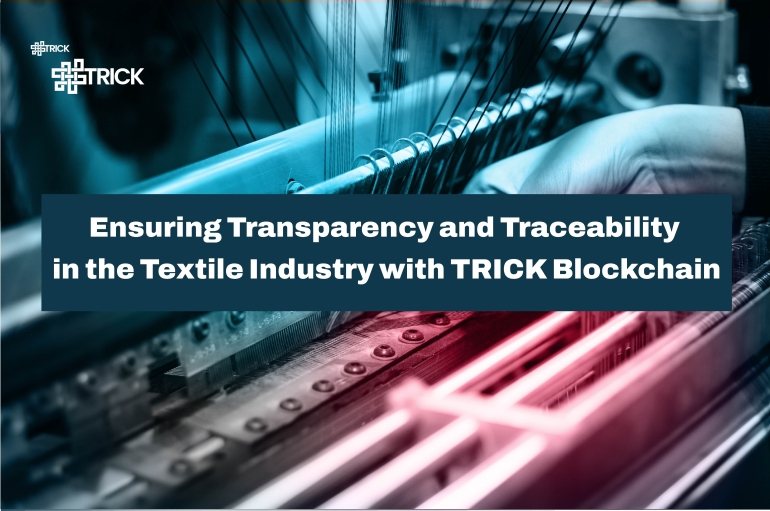Ensuring Transparency and Traceability in the Textile Industry with TRICK Blockchain

Even though textiles and clothing are highly creative industries, they lack an effective mechanism for proving the origin of materials and establishing trust among suppliers and consumers. Data integrity, auditability, and traceability are paramount in ensuring transparency and visibility across the value chain, leading to enhanced product circularity. The exchanged data between different entities, whether business or governmental organisations, should be stored securely and audited.
As well as in other industries, the production process of the textile industry involves multiple actors and various sub-products. For this reason, it can be challenging to establish trust and understand the entire manufacturing process, as different suppliers and merchandisers are involved in providing various components of the final product.
Determining the production process, the type of fabrics used, and whether the production process complies with health and social regulations can be difficult, especially when some merchandisers are unknown. Hence, supply chain transparency is a significant challenge that the fashion industry must overcome. Ensuring transparency is crucial to build trust with stakeholders throughout the value chain and is an essential element of effective product management.
Today, governments and customers are placing greater demands on businesses to improve the traceability of their products. Due to the vast complexity of the textile industry, the lack of first-hand data collection, and data inconsistencies, such analysis is subject to many limitations and uncertainties.
Collaboration among stakeholders, including the final consumer, is necessary to address the issue of supply chain traceability and establish trust. Technical solutions can facilitate the transition. In parallel, there are several other issues related to fraud, as there is no digital control over the garments used for production, and all current proofs are based on hard copies that can be easily altered. The use of a blockchain infrastructure and smart contracts may help in enforcing sustainable practices, traceability solutions, and identifying non-conformance.

Photo credits: Janko Ferlič
As the need for general trust increases with global business, the visibility and immutability of public blockchain transactions help to build and ensure trust that data is fair and accurate. Since the data posted on the blockchain ledger is immutable, the record it maintains right from the inception is highly trustworthy, and nobody has a reason to doubt its authenticity. Organisations involved in a transaction, and even regulators, can verify and determine whether the data and related transactions are valid or not. In addition, if data cannot be altered, the authentic history is automatically maintained.
Today, blockchain technology has expanded its use cases to make the sector highly efficient and transparent. The role of the blockchain is essential in providing the necessary features to guarantee the trustworthiness of any data stored in the TRICK platform.
Therefore, the role of blockchain in TRICK is to provide an end-to-end secure, reliable, and auditable record of transactions generated by TRICK services and to provide verifiable certificates of them, such as PCO certificates. In addition, the deployed smart contracts can promote transaction credibility between contracting parties without the need for third parties, as in regular contracts, because of the security and decentralised system supported by blockchain technology.
The overall design of the TRICK blockchain infrastructure (led by UBITECH) combines two open-source blockchain technologies: Hyperledger Fabric and the Quadrans blockchain. The latter being a blockchain solution with a strong focus on industry needs, supported and developed by TRICK partner Quadrans Foundation.
The TRICK blockchain design is based on both private and public blockchain distributed ledgers, offering data integrity, transparency, auditability, and interoperability. Such a blockchain network should be a permissioned network that only allows access to authenticated and authorised members to provide the highest level of security guarantees. The inclusion of a public network storing public information will also enhance the traceability and verifiability of the process. Aligned with the use of eIDAS, an attribute-based access control mechanism for authorisation is managed internally by the private blockchain, while a public channel provides enhanced verification to third-party entities.
For readers interested in learning more about how blockchain technology can be applied to the textile industry, here is another article jointly written by TRICK partner UPC and the Quadrans Foundation, entitled The Advantages of Blockchain Technology for the Textile and Fashion Industry.
CONTACT PERSON & EMAIL ADDRESS:
- Sofianna Menesidou (email)
LINKS:
- TRICK Partners Quadrans Foundation and UPC on the Advantages of Blockchain Technology for the Textile and Fashion Industry (link)
- Quadrans Foundation to provide the Blockchain Technology Infrastructure for TRICK (link)